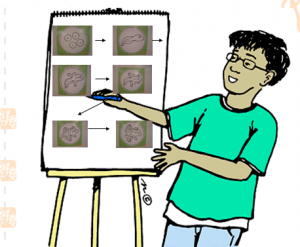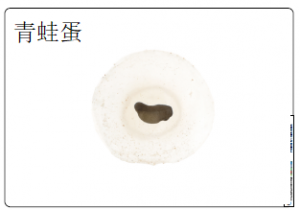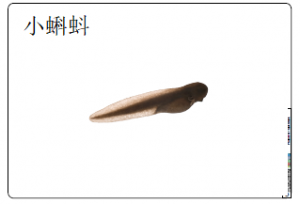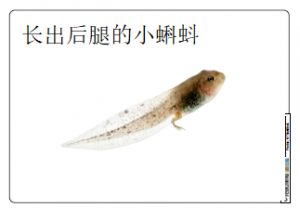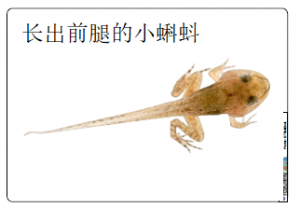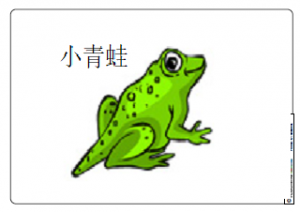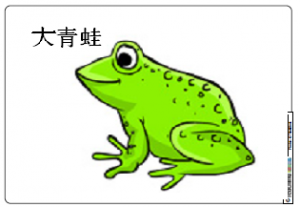8 袁秋萍
Lesson Plan: 小蝌蚪找妈妈/青蛙的生命周期
Qiuping Yuan袁秋萍
| School Type: Public | Number of students: 18 |
| Grade: Kindergarten | Proficiency Level: Novice-low |
| Teaching minutes: 50 minutes | Methods: shared reading/TPR |
| Topic:《小蝌蚪找妈妈》 and 《青蛙的生命周期》 | |
| (共五天教学活动, 主要运用分享阅读教学法) |
Status of Students (Characteristics, knowledge level, background, etc.) |
| This is a 50 minutes Chinese class for kindergartners. No prerequisites are required to meet prior to the class starting. |
ACTFL Standard Descriptions |
|
口语:初级初等 NOVICE LOW-SPEAKING Speakers at the Novice Low sublevel have no real functional ability and, because of their pronunciation, may be unintelligible. Given adequate time and familiar cues, they may be able to exchange greetings, give their identity, and name a number of familiar objects from their immediate environment. They are unable to perform functions or handle topics pertaining to the Intermediate level, and cannot therefore participate in a true conversational exchange. 阅读:初级初等HTTPS://WWW.ACTFL.ORG NOVICE LOW-READING At the Novice Low sublevel, readers are able to recognize a limited number of letters, symbols or characters. They are occasionally able to identify high-frequency words and/or phrases when strongly supported by context. |
Lesson’s Content Focus/ Objective |
|
Theme or Topic: 《青蛙的生命周期》 Words: 大, 小, 长, 短, 蝌蚪, and 青蛙 Cultural perspectives: Frog is a good symbol in Chinese culture Performance-based Objectives—As a result of this lesson/unit, students will be able to:
|
Materials needed: |
|
Laminated, magnetic vocabulary flash cards:大, 小, 长, 短, 蝌蚪, and 青蛙
|
Procedure: questions the teacher needs to consider for the activity design |
|
| Procedure | Purpose | What the teacher does: | What the students do: |
| Warm up Activity and pre-assessment:
(5m) What do you see? |
Tap the students’ prior knowledge |
|
|
| Activity 1:
(10m) Frog life cycle video |
Teach the frog life cycle in Chinese |
|
|
| Activity 2:
(10m) Throw the dice |
Get more familiar with the vocabulary |
|
The students as a group actively guess which card will be on the top in Chinese while acting out.
|
| Activity 3:
(10m) Which character is missing? |
Practice recognizing the 6 high frequency words in the reading. | Put the six Chinese character flashcards 大, 小, 长, 短, 蝌蚪 and 青蛙 on the board and practice a couple of times with the students, and then cover the flash cards with a piece of fabric on the carpet, the teacher takes one flash card away, opens the fabric and asks the kids which card is missing. Repeat a couple of times. 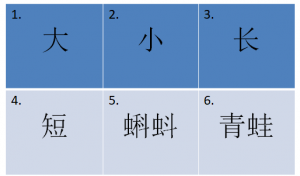 |
|
| Activity 4:
(10m) The frog life cycle reading |
Practice how to read the life cycle in Chinese |
|
|
| Activity 5:
(5m): Closing activity |
Assessment/Evaluation:
Ask kids questions about what is learned. |
a) Say the life cycle of the frog. b) What does the tadpole’s head look like? c) Which two legs grow first? Front legs or back legs? d) When does the tail disappear? e)Recognize the high frequency words as a group: 大, 小, 长, 短, 蝌蚪 and 青蛙 |
The students take turns to answer these questions. |
Homework |
|
Family assignments:
|
Notes |
|
The teaching and learning is a five-day process that heavily involves the shared reading method. “The Life Cycle of the Frog” is the second day lesson plan. The five-day units involve a group of correlated activities that are designed around the topic. We use “the Little Swallow” melody for teaching the whole reading. The kids sing along the whole story .The following is the simplified story version link: https://docs.google.com/document/d/1bkQyAUWP1LyWJFcuN7X-kbwEgMRoa4sDW95yKka5L7Q/edit?usp=sharing) |
Lesson Plan Analysis |
|
Teaching philosophy Shared reading method provides an environment that fosters and encourages active involvement from all students. The teacher will prepare a large picture book that tells a story. The pictures are to be large enough so that the whole class can see it. The pictures need to be in a story format order (beginning to end). Through shared reading children experience and enjoy the whole story. The activities of the lesson plan build on students' interests. It is best to focus on topics that are relevant to their lives. Students will be able to connect the topics to real-life experiences. Shared reading is also a great opportunity for students to practice speaking and listening. Pictures can help the children get a better understanding of what is happening in the story and the meaning of the words being read. Shared reading helps to foster the speed in which the students learn. (The following is a video link of a kindergarten students following this method: https://www.youtube.com/watch?v=VllCxyL0MI0) Teaching Methods and Strategies Use of music and gestures for young students is very helpful. It paints a picture and provides reminders of the lesson study. Constant change of activities helps address the students’ short attention span. Howard Gardner's multiple intelligences theory is very helpful for designing lesson plans and activities because it targets different learning styles. A variety of learning methods are used in this lesson plan according to this theory: video, audio, music and TPR, including American sign language. The kids learn the lesson study through contextualization with comprehensible input. Through ample input, the kids easily accomplish language fluency. Special focus and features of the plan Reading another language can start as early as kindergarten. Shared reading is a good way for young kids. But age-appropriate, content-appropriate and language proficiency level factors should be taken into consideration when reading materials are chosen. This is especially important for second language learners. The do-statement goals for this lesson plan is reached by the higher level of accomplishment by the students. Suggestions for users The book, “Little Tadpoles Looking for Their Mom,” is a five day lesson plan. The ‘life cycle’ of the frog’s life is one of the five days of this lesson plan. It is also an age appropriate topic. |
Author Bio |
|
English: Qiuping Yuan obtained her Master Degree of Arts in China and Master Degree of Arts at Michigan State University. She also received her teaching certificate in Michigan. She is currently a Mandarin teacher for the Lakeshore Public School District in Michigan. She was awarded “Teacher of the Year” by Chinese Language Association of Michigan in 2015. She won two awards by the Chinese Language Teachers Association, USA, in 2015 and 2016. She has published a couple of papers in the U.S. |
|
Chinese: 袁秋萍,英美文学、教育学双硕士。在密西根州立大学教育系修完教师证项目和硕士学位,通过密西根州教师证考试。现任美国公立学校初中、高中部中文教师。曾经担任过美国公立学校小学、高中特殊教育班、高中12年级senior leadership 以及AP中文的任课老师。 2015年被Chinese Language Association of Michigan评为teacher of the year。2015年和2016年分别获得过全美中文教师协会的奖(the Chinese Language Teachers Association, USA)。多次在全美和密西根州做过教学讲座,在美国教学期刊发表过数篇教学文章。 |

